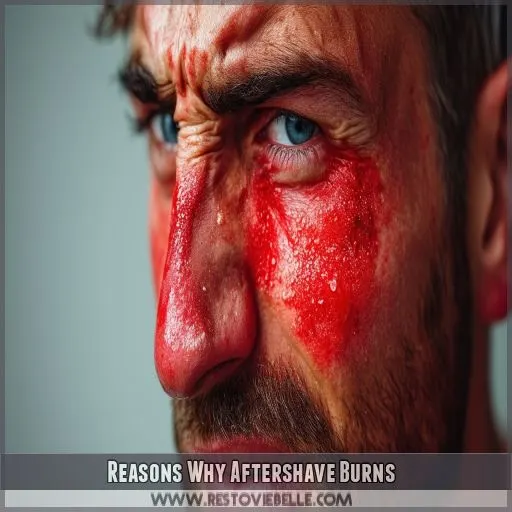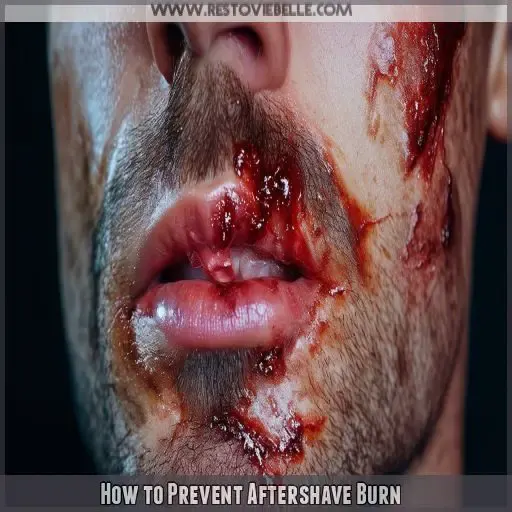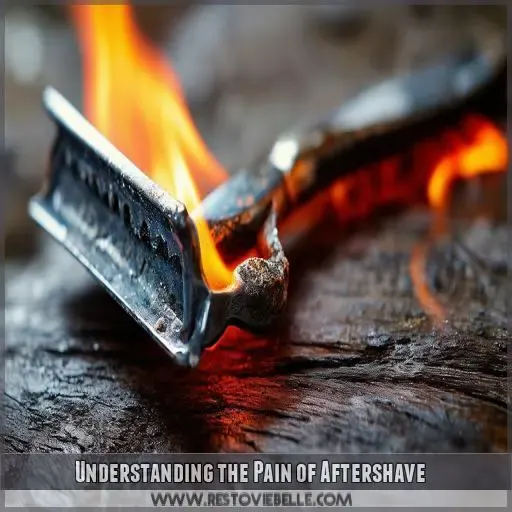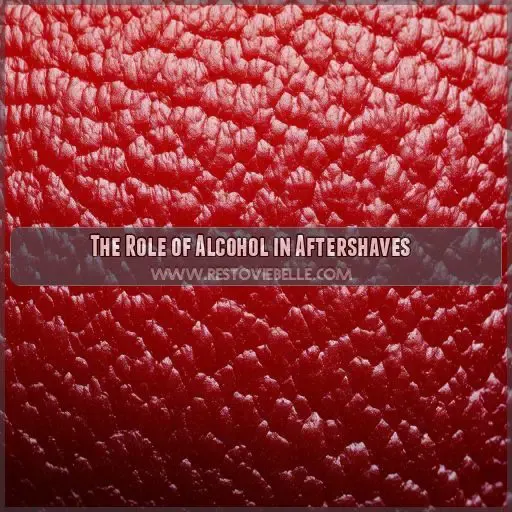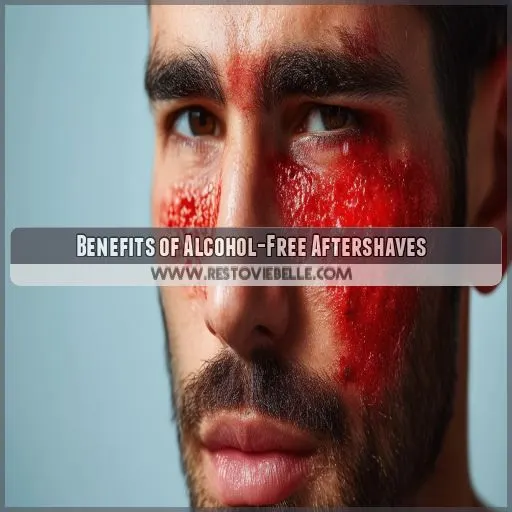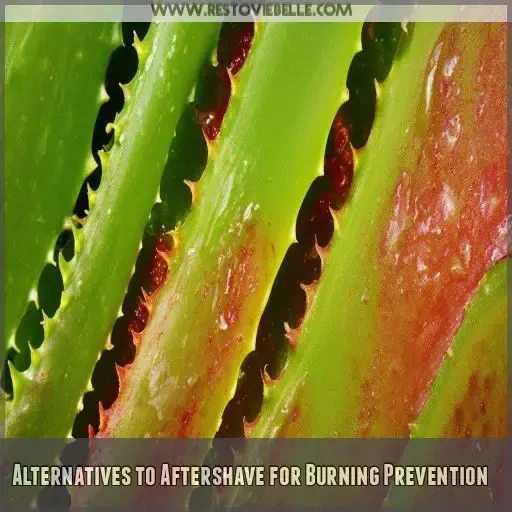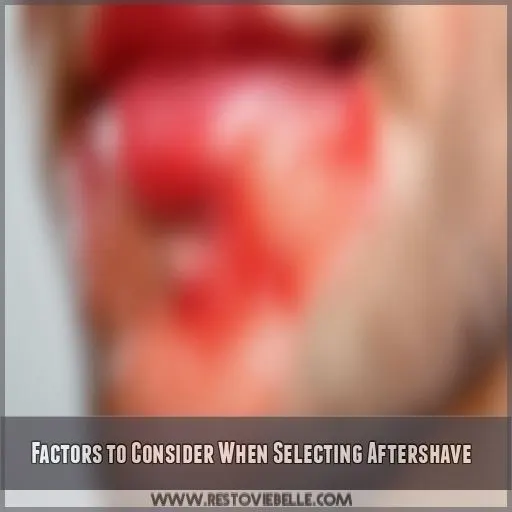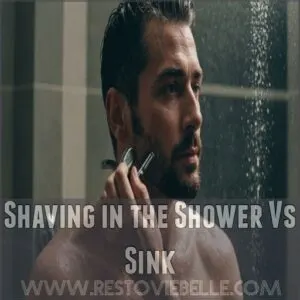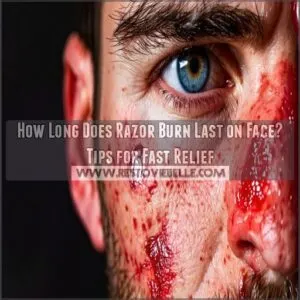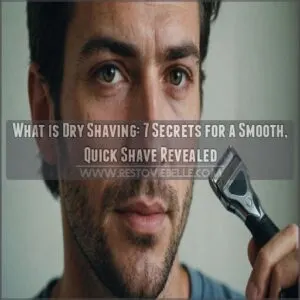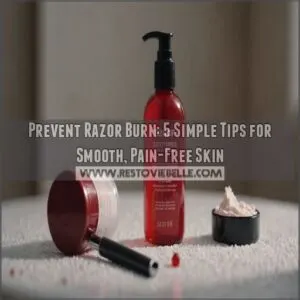This site is supported by our readers. We may earn a commission, at no cost to you, if you purchase through links.
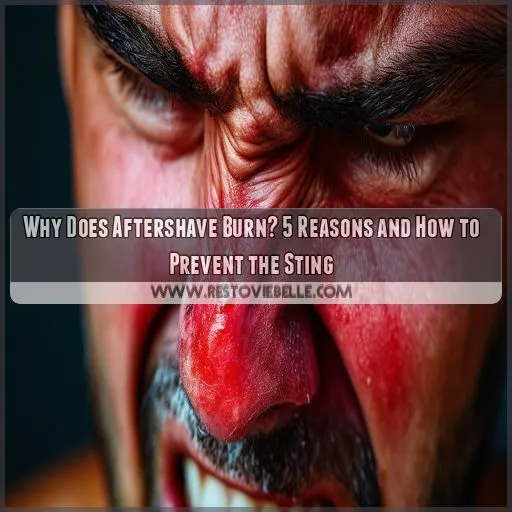
We will explain in this article why aftershave burns and share some practical tips for a comfortable and soothing post-shave experience. Say goodbye to the burn!
Table Of Contents
- Key Takeaways
- Why Does Aftershave Burn?
- Reasons Why Aftershave Burns
- How to Prevent Aftershave Burn
- Understanding the Pain of Aftershave
- The Role of Alcohol in Aftershaves
- Benefits of Alcohol-Free Aftershaves
- Alternatives to Aftershave for Burning Prevention
- Factors to Consider When Selecting Aftershave
- Frequently Asked Questions (FAQs)
- Why does my skin burn after applying aftershave?
- How do you stop aftershave from burning?
- Why is aftershave bad?
- Is aftershave harmful to skin?
- How long does aftershave burn typically last?
- Can aftershave burn cause long-term skin damage?
- Does the type of razor used affect aftershave burn?
- Can certain medical conditions worsen aftershave burn?
- How can I soothe the burning sensation immediately?
- Conclusion
Key Takeaways
- Say goodbye to the sting! Aftershave burn is a common issue, but it doesn’t have to be. Understand why it happens and take steps to prevent it.
- Your skin is like a delicate flower, so treat it with care. Alcohol-based aftershaves can be harsh and irritating, especially for sensitive skin. Opt for alcohol-free options to keep your skin happy.
- Shaving can be a bit like a battlefield, but it doesn’t have to end in pain. Use proper shaving techniques and a mild razor to minimize skin damage and irritation.
- Aftershave should be your skin’s best friend, not its enemy. Choose products that are compatible with your skin type and avoid harsh ingredients. Your skin will thank you for it!
Why Does Aftershave Burn?
Aftershave burns because it often contains high alcohol content that reacts with the tiny cuts and abrasions you get from shaving. This alcohol acts as an antiseptic, killing bacteria but also dehydrates your skin, causing dryness and irritation.
The burn happens when the alcohol hits these cuts, activating vanilloid receptors, which makes the pain receptors more sensitive, leading to that stinging sensation. Additionally, if your skin type isn’t compatible or if your shaving technique is off, the burn can get worse.
Interested in finding out how to prevent this irritating sting? Let’s explore some effective tips and alternatives.
Reasons Why Aftershave Burns
You might be wondering why your aftershave causes a burning sensation. The main culprits are high alcohol content, skin incompatibility, excessive skin damage, using it as a first-aid solution, and using the wrong razor.
High Alcohol Content
You might experience aftershave burn due to high alcohol content. This happens because:
- Alcohol acts as an antiseptic
- It dehydrates your skin
- It can irritate sensitive skin
- Non-moisturizing formulas exacerbate the burn
Consider low-alcohol or alcohol-free alternatives for a gentler experience.
Incompatibility With Skin Type
Although the stinging sensation caused by alcohol is very ordinary, it really depends on your skin type. If you have too-sensitive skin, aftershave ingredients may cause irritation or allergic reactions. Seek out soothing components to assist your unique complexion.
Excessive Skin Damage
If you exfoliate too harshly or over-shave, it leads to excessive skin damage. This makes your skin sensitive and increases the risk of aftershave rash and irritation, exacerbating aftershave burn.
Using It as First-Aid Solution
Using aftershave as a first-aid solution can burn due to your skin’s sensitivity to alcohol. Consider antiseptic substitutes like witch hazel to minimize irritation and avoid aggravating vanilloid receptors-1.
Wrong Razor Usage
It can give razor burns using the wrong razor. Other factors that may arise are razor blade sharpness, weight of the handle, pressure at an angle, shaving head design, and the alignment of blades. Utilize good shaving techniques to lessen irritation.
How to Prevent Aftershave Burn
To prevent the sting of aftershave, choose an aftershave that suits your skin type and needs. Proper shaving technique and using a mild razor can also help avoid the burning sensation.
Choose Suitable Aftershave
Choosing the right aftershave helps prevent that dreaded burn. Aim for products that suit your skin’s sensitivity and watch out for harsh ingredients.
- Ingredients: Opt for natural, moisturizing components.
- Fragrance: Avoid strong scents that can irritate.
- Application techniques: Apply gently.
- Brands: Select reputable aftershave brands.
Proper Shaving Technique
Practice good shaving techniques: prepare the skin before shaving by washing it with warm water and then by using pre-shaving oil. Next, apply a thick shaving cream and shave with a sharp razor blade. Always shave in the direction your hair grows, using small and light strokes. This reduces irritation and allows for smooth aftershave application.
Opt for Mild Razors
Opt for mild razors to prevent aftershave burn. Disposable razors or electric shavers are gentler on sensitive skin than manual razors with sharp blades. Avoid razors with fragrances, which can further irritate. Look for natural ingredients like aloe vera to soothe skin after shaving and prevent that stinging sensation.
Understanding the Pain of Aftershave
Aftershave burns because the alcohol in it reacts with tiny cuts, stimulating the vanilloid receptors that make your skin think it’s on fire. This stinging sensation is a common reaction to the antiseptic properties of alcohol.
Alcohol’s Reaction With Cuts
When aftershave containing alcohol touches tiny cuts from shaving, the alcohol reacts with your skin, causing a burning sensation. Alcohol’s antiseptic properties kill bacteria but can also dry out and irritate your skin, especially if it’s sensitive.
If you have ingredient allergies or heightened skin sensitivity, the chemical reactions can worsen the sting. Consider opting for aftershave substitutes like moisturizers or alcohol-free balms to prevent irritation and better soothe your skin post-shave.
Vanilloid Receptors Activation
When you apply aftershave, it can sting because it activates vanilloid receptors in your skin. These receptors are tied to sensory neurons and nerve endings.
Alcohol and other ingredients react with tiny cuts, causing your skin to think it’s burning. Pain perception is heightened, leading to irritation.
This reaction tricks your brain into feeling more discomfort than actual damage, making the entire process more unpleasant than it should be.
The Role of Alcohol in Aftershaves
Alcohol in aftershave acts as an antiseptic, killing bacteria but also dehydrating your skin. This can lead to a harsh, burning sensation, especially if you have cuts or sensitive skin.
Antiseptic Property
Alcohol in aftershave acts as an antiseptic, killing bacteria that can cause skin irritation. This disinfecting property helps prevent infection after shaving. However, alcohol can also be harsh on the skin, leading to dryness and further irritation. Consider alcohol-free alternatives that use soothing ingredients like aloe vera or witch hazel, which can provide antiseptic benefits without the same level of skin irritation.
- Alcohol kills bacteria to prevent infection
- But it can also dry out and irritate skin
- Seek out gentler, alcohol-free options with calming ingredients
Dehydration and Harshness on Skin
Alcohol in aftershaves can lead to dryness and skin irritation. It dehydrates the skin, stripping away natural oils and causing sensitivity. This harshness can exacerbate any skin damage from shaving. Opt for natural alternatives with non-alcoholic antiseptic agents to avoid this discomfort.
| Alcohol Effect | Skin Reaction | Solution |
|---|---|---|
| Dehydration | Dryness | Moisturizers |
| Irritation | Redness | Aloe Vera, Witch Hazel |
| Harshness | Skin Damage | Non-alcoholic ingredients |
Benefits of Alcohol-Free Aftershaves
Using alcohol-free aftershaves can help prevent the stinging sensation you often get from traditional aftershaves. These products contain non-alcoholic antiseptic agents like aloe vera or witch hazel, which soothe and moisturize your skin without causing irritation.
Non-Alcoholic Antiseptic Agents
Alcohol-free aftershaves contain non-alcoholic antiseptic agents that can effectively disinfect and protect your skin without the harsh drying effects. These formulas often include soothing ingredients like aloe vera or witch hazel, which can calm redness and prevent irritation. Say goodbye to the sting and hello to a comfortable, healthy post-shave experience.
- Antiseptic properties without alcohol
- Skin-compatible soothing agents
- Reduces redness and prevents irritation
Aloe Vera or Witch Hazel Inclusion
Try to reach for alcohol-free aftershaves that contain what really should help to make all the difference in your skin: aloe vera or witch hazel. Both have some impressive benefits:
| Aloe Vera Benefits | Witch Hazel Benefits | Natural Skin Remedies |
|---|---|---|
| Soothes irritation | Reduces swelling | Perfect for sensitive skin |
| Moisturizes deeply | Acts as an astringent | Alcohol-free skincare |
| Heals cuts & burns | Fights bacteria | Soothing aftershave |
| Soothes redness | Prevents inflammation | Improves skin health |
These natural ingredients ensure your skin stays calm, healthy, and irritation-free.
Alternatives to Aftershave for Burning Prevention
If aftershave burns your skin, consider alternatives like pre-shave oil or a good moisturizer. You might also try using shaving cream, an alum block, or witch hazel to minimize irritation and protect your skin.
Pre-Shave Oil
Before shaving, apply a pre-shave oil to lubricate and protect your skin. The natural ingredients soothe sensitive areas and reduce irritation for a smoother, more comfortable shave.
Shaving Cream
Using shaving cream can prevent razor burn, shaving rash, and skin irritation. It helps the razor glide smoothly, reducing the risk of razor bumps and keeping your skin protected and hydrated.
Moisturizer
Applying moisturizer after shaving hydrates and protects your skin. Look for natural ingredients like aloe vera. Choose a consistency that suits your skin type for smooth, irritation-free results.
Alum Block
An alum block is a natural astringent that can soothe irritation and reduce redness after shaving. Simply rub it on the affected areas to calm your skin.
Witch Hazel
Witch hazel is a soothing alternative to aftershave, helping to reduce irritation and redness. Its benefits include:
- Soothing inflammation
- Minimizing razor bumps
- Promoting skin healing
Avoid witch hazel side effects.
Factors to Consider When Selecting Aftershave
When selecting an aftershave, consider your scent preferences, texture needs, and budget to find the best fit. Look for natural ingredients like aloe vera or chamomile, and avoid harsh chemicals that can irritate your skin.
Scent Preferences
When choosing an aftershave, consider your scent preferences to avoid skin sensitivity or allergic reactions. Look for fragrance-free options if you have fragrance sensitivity, and find one within your price range.
Texture Choices
Choosing the right aftershave texture is crucial. Options include:
- Balm: Thick and moisturizing
- Splash: Light and fast-absorbing
- Lotion: Creamy and hydrating
- Gel: Soothing and lightweight
Natural Ingredients
Look for aftershaves with soothing ingredients like aloe vera, chamomile, or lavender. These natural remedies cater to skin sensitivity and offer hypoallergenic options to prevent skin irritation.
Avoidance of Harsh Chemicals
Avoid harsh chemicals like artificial fragrances and colors that can irritate your skin. Instead, opt for natural, soothing ingredients that won’t cause a burning sensation after shaving.
- Look for gentle, skin-compatible aftershave formulas
- Prioritize natural, nourishing ingredients over harsh chemicals
- Prepare your skin properly before shaving to minimize irritation
- Choose a razor that won’t cause excessive skin damage
Price Considerations
Consider the price you’ll like to pay. Ensure quality within budget constraints. Check the reputation of brands to guarantee value for money. Affordable products whose ingredients are natural help in preventing aftershave burn and soothe your skin.
Frequently Asked Questions (FAQs)
Why does my skin burn after applying aftershave?
It’s like your skin’s on fire because aftershave often contains alcohol, which reacts with tiny cuts from shaving, irritating your skin. High alcohol content, not matching your skin type, or damaged skin can exacerbate the burn.
How do you stop aftershave from burning?
If you’re seeking to aevoid burning after shaving, consider alcohol-free aftershave, follow proper shaving techniques, and keep your skin well-moisturized. Be on the lookout for soothing ingredients like aloe vera and avoid applying aftershave to broken skin.
Why is aftershave bad?
Don’t let aftershave be the thorn in your side – choose wisely to avoid the sting. Alcohol-based formulas can dry and irritate skin, while alcohol-free options soothe and heal for a comfortable post-shave experience.
Is aftershave harmful to skin?
Aftershave isn’t inherently harmful, but it can irritate your skin, especially if it contains alcohol, which dehydrates and stings. Choose an alcohol-free, moisturizing option to reduce redness and prevent irritation.
How long does aftershave burn typically last?
Imagine the sting, like tiny flames on your skin, firing up right after application. Aftershave burn typically lasts only a few minutes, as it quickly dissipates once the alcohol evaporates and your skin acclimates.
Can aftershave burn cause long-term skin damage?
While aftershave burn is typically temporary, prolonged exposure to harsh ingredients can potentially lead to long-term skin irritation or damage. Be mindful of your skin type and choose an aftershave that’s gentle and compatible.
Does the type of razor used affect aftershave burn?
Yes, the type of razor you use affects aftershave burn. Using a mild razor causes less skin damage, reducing irritation. On the other hand, a rougher razor can lead to more nicks, making the burn more intense.
Can certain medical conditions worsen aftershave burn?
Yes, underlying medical conditions like eczema, rosacea, or psoriasis can worsen aftershave burn. Your skin’s increased sensitivity and irritation from these conditions make it more susceptible to burning and discomfort when using aftershave.
How can I soothe the burning sensation immediately?
To soothe the burning sensation, rinse the affected area with cool water and apply a gentle, fragrance-free moisturizer. This can help calm the irritation and provide relief.
Conclusion
Did you know 70% of men report experiencing aftershave burn? Now that you understand why aftershave burns, you can take steps to prevent it.
Opt for alcohol-free options, use proper shaving techniques, and select products that suit your skin type. Remember, choosing the right aftershave and shaving tools can make a significant difference in your comfort.
Follow these tips, and say goodbye to the sting for a smoother, more enjoyable post-shave experience.

